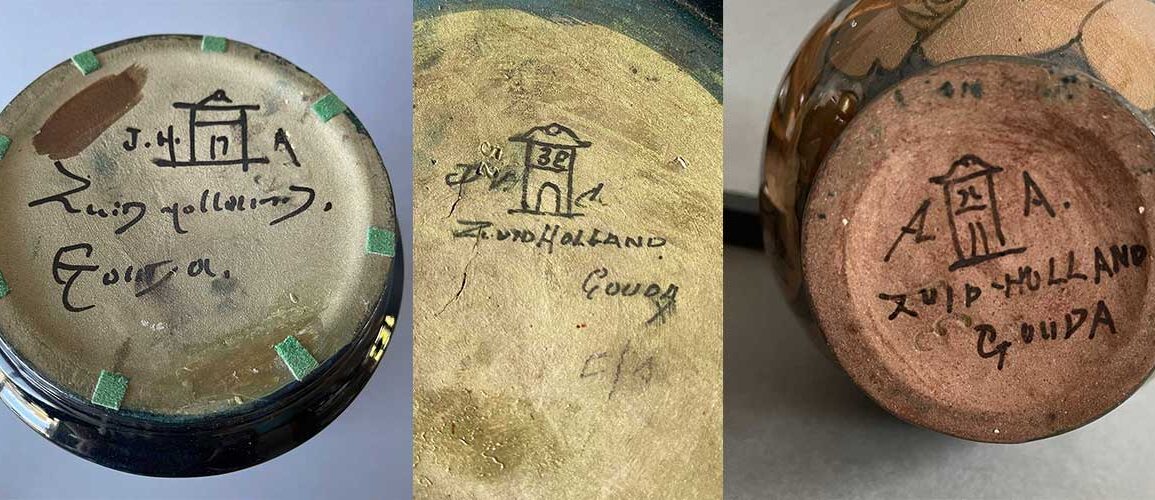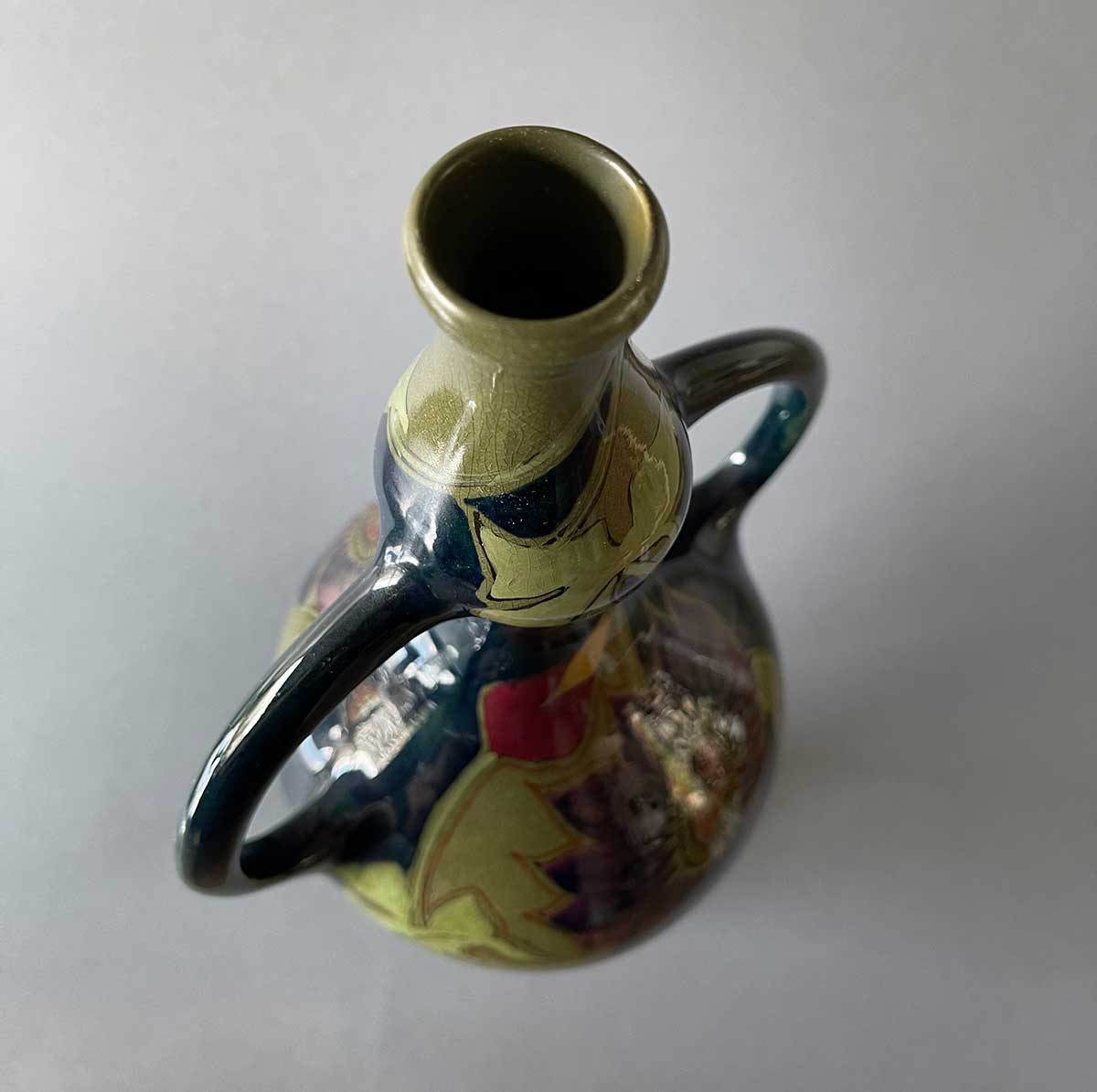There are several ways to tell the age of your antique Gouda pottery. Vases, ewers and wall chargers from the Zuid-Holland pottery factory from Gouda in the Netherlands are collected all over the world. All objects were made between 1898 and 1965. Very early pottery is highly sought after by collectors. It is therefore essential to know how old your pottery is, if you want to be able to estimate its value.
From 1898: Glossy Gouda Pottery in the Art Nouveau style
In the first years of production, Pottery factory Zuid-Holland (PZH) made decorative pottery, painted in the Art Nouveau or Jugendstil style. This particular style was very fashionable at the time PZH started it’s business. Vases, chargers and ewers were painted in dark colours and mostly floral and symmetrical decors with the typical Art Nouveau style elements and free flowing and organic designs. PZH used coloured paint based on metal oxide and painted objects were covered with a high-gloss glaze.

From 1901: P-decor, white coloured pottery, painted in pastel shades
In 1901, PZH introduced the ‘P-decor’, with light, pastel shades on a white background. The colours were applied to the biscuit in waves or lines, which is why the decor is also called ‘Kantjes’ in Dutch (meaning: lace). The P-decor was an attempt by the Gouda pottery factory to compete with the very popular, but expensive eggshell porcelain from the Rozenburg company in the Hague. Later in 1908, the NP-decor was introduced with modified designs made by Willem P. Hartgring, who previously worked at Rozenburg.

From 1909: Gouda Pottery with matte glaze
From 1909, PZH developed a matt glaze on the pottery, which was very popular on the market. Matte glaze was an innovation by Daniel Harkink. He painted vases and dishes, often in oriental decors with bold colour schemes and a matte glaze. The white pottery was also given a matte variant, called: mat bloemen (flowers) and mat vogels (birds).

Not everything shinny is old
You could say that dark coloured Gouda pottery with a high-gloss glaze is the oldest. Only that’s not quite true. Shinny glazed pottery was manufactured until the 1930’s. Ornate Jugendstil decors were also produced, when Art Nouveau was actually already ‘out of fashion’. And also in large quantities, simply because there was a continued demand from the market. If you want to identify early Gouda pottery, you will have to look for more clues.
Markings: new light on year letters
A lot of research has been done into antique Gouda pottery in the past. Rob Hageman published an article in 1981 about the theory of year letters. Based on his research, he stated that early Gouda pottery was signed with an extra letter. The letter A referred to the first year of production: 1898 and the letters would continue until 1905 (with the letter H). This theory has been widely used over the past 40 years. In recent years experts have become more and more doubtful about the correctness of this theory. Recent new research has been done on the basis of a much larger group of objects from early Gouda pottery. And a new theory indicates that the letters on early Gouda pottery do not so much indicate the production year, but are a indication of the use of certain decors. Specifically: about decors in relation to the model (so A is the first decor on model x, B the second on model x, C the third, etc). This decor-on-model coding was used in the first years of production, between 1898 and 1900. So if antique Gouda pottery contains a letter on the bottom, next to a monogram, it therefore originates from the nineteenth century. You can read the entire study on the Ridgetop Collection website, click here.

The logo of PZH: the Lazarus gate
Objects from the Dutch Pottery factory Zuid-Holland from Gouda always have markings on the bottom. Usually you see a little house or gate, as the factory logo. That little house refers to the Lazarus Gate in Gouda, a monumental gate way that use to be in the vicinity of the factory. The little house has many different shapes. Usually there is a semicircular door in the gate and it usually has a sloping roof. Sometimes the roof has a semicircular top or a circle at the top and sometimes you see decoration in the form of two E’s or a cross underneath the roof. In principle, the ‘execution’ of the logo does not say much about the age of the pottery. Even though many people think that the more richly decorated gates are a sign of early Gouda pottery. However, the shape of the logo differs from painter to painter and therefore says more about style than just about age (see examples in the photo above).
The name of the factory
You can expect all kinds of names, signed at the bottom of Gouda pottery pieces. Different names were used for the factory in different periods. And this gives a good indication of the age of Gouda pottery. Very early pottery is almost always signed with the words: Zuid-Holland Gouda.
Around the turn of the century, the signature changed. PZH wanted to make its introduction abroad with the start of foreign trade and especially the participation in the world exhibition in Paris (from April 15th till November 12, 1900). PZH objects were signed around 1900 with the words: Made in Zuid-Holland.
From 1908 the ‘made-in’ disappeared and PZH plateel was signed again with Zuid-Holland Gouda or simply Holland Gouda.
Model numbers of plateelbakkerij Zuid-Holland
Another indication for the age of Gouda pottery is the model number. Almost all objects of the Dutch Pottery Factory Zuid-Holland have a model number on the bottom of the objects. Usually this is carved by hand or pressed into the clay with a stamp. You could argue that very low model numbers are older than very high ones. A PZH catalog from 1909 has been preserved, in which all model numbers 1 to 526 are depicted. So it can be assumed that all model numbers up to the number 526 are produced before the year 1909.
But of course there are also exceptions to this. PZH worked with different model categories. An example of this is model series 2000 intended for models with relievo. Model series 3000, intended for the Delft decor. Model series 4000, which was used for tableware, and model series 5000, which is about so-called ‘Rozenburg models’. These high numbers also refer to early Gouda pottery and were used in the period between 1901 and 1910. But beware: model numbers have been know to be reused in different periods.
Gouda Pottery master painters
The best way to date Gouda pottery is to look at who painted the objects and to look up the period when this pottery painter worked at the factory. There are several sources that can identify famous pottery painters by the monograms they left on the pottery. Such a monogram is often made up from the first letter of the first name and last name of the pottery painter. A frequently used source is the book ‘n.v. Koninklijke Plateelbakkerij Zuid-Holland’ which was published by Waanders Publishers in 1994. The voluminous ‘The Gouda Pottery Book’ from 2007 also contains a lot of information. Both books contain extensive lists of monograms with the corresponding list of names and production periods. The most recent source of information is the Ridgetop Collection website. There you will find a database with information about early PZH pottery painters and examples of their monogram, their way of marking and the objects painted by them. The database also contains research into the population registers and briefly describes the lives of the painters and designers. This is where I look up all the information on Gouda pottery painters and their working periods at the Zuid-Holland factory. The database also contains many early PZH models and decors.
PZH year marks
Only after the First World War did PZH introduce a system with year signs. By using dashes, a pattern of symbols was formed. Below is an overview of the symbols used per year. But beware: This applies to Gouda pottery that was produced from 1918 to 1931. From 1928 the name Plazuid was also used in signatures and from 1930 the factory was given the Dutch Royal seal of approval and a crown appeared at the bottom of the pottery.



